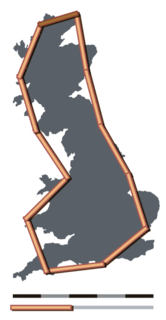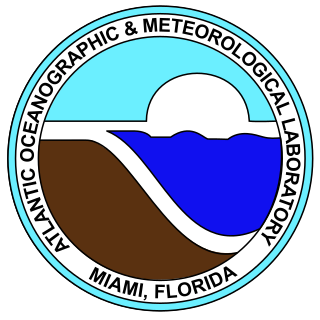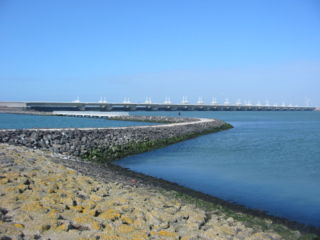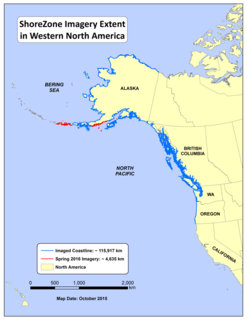
States shaded light blue have Great Lakes coastline.*
States shaded white have no coastline.
* New York has both ocean and Great Lakes coastline
This is a list of U.S. states ranked by their coastline length. Thirty states have a coastline: twenty-three with a coastline on the Arctic, Atlantic, and/or Pacific Ocean, and eight with a Great Lakes coastline; New York has coasts on both. States with no coastline are not included; smaller border lakes such as Lake Champlain or Lake of the Woods are not counted.

In the United States, a state is a constituent political entity, of which there are currently 50. Bound together in a political union, each state holds governmental jurisdiction over a separate and defined geographic territory and shares its sovereignty with the federal government. Due to this shared sovereignty, Americans are citizens both of the federal republic and of the state in which they reside. State citizenship and residency are flexible, and no government approval is required to move between states, except for persons restricted by certain types of court orders. Four states use the term commonwealth rather than state in their full official names.

The coast, also known as the coastline or seashore, is the area where land meets the sea or ocean, or a line that forms the boundary between the land and the ocean or a lake. A precise line that can be called a coastline cannot be determined due to the Coastline paradox.

The Great Lakes, also called the Laurentian Great Lakes and the Great Lakes of North America, are a series of interconnected freshwater lakes primarily in the upper mid-east region of North America, on the Canada–United States border, which connect to the Atlantic Ocean through the Saint Lawrence River. They consist of Lakes Superior, Michigan, Huron, Erie, and Ontario, although hydrologically, there are four lakes, Superior, Erie, Ontario, and Michigan-Huron. The connected lakes form the Great Lakes Waterway.
Contents
Two separate measurements are used: method 1 only includes states with ocean coastline and excludes tidal inlets; method 2 includes Great Lake coastline and the extra length from tidal inlets. For example, method 2 counts the Great Bay as part of New Hampshire's coastline, but method 1 does not. The resulting figures differ significantly due to the ambiguity inherent in all attempts at measuring coastlines, as expressed in the coastline paradox.

Great Bay is a tidal estuary located in Strafford and Rockingham counties in eastern New Hampshire, United States. The bay occupies over 6,000 acres (24 km2), not including its several tidal river tributaries. Its outlet is at Hilton Point in Dover, New Hampshire, where waters from the bay flow into the Piscataqua River, thence proceeding southeast to the Atlantic Ocean near Portsmouth. The northern end of the bay, near its outlet, is referred to as Little Bay.

New Hampshire is a state in the New England region of the northeastern United States. It is bordered by Massachusetts to the south, Vermont to the west, Maine and the Atlantic Ocean to the east, and the Canadian province of Quebec to the north. New Hampshire is the 5th smallest by area and the 10th least populous of the 50 states. Concord is the state capital, while Manchester is the largest city in the state. It has no general sales tax, nor is personal income taxed at either the state or local level. The New Hampshire primary is the first primary in the U.S. presidential election cycle. Its license plates carry the state motto, "Live Free or Die". The state's nickname, "The Granite State", refers to its extensive granite formations and quarries.

The coastline paradox is the counterintuitive observation that the coastline of a landmass does not have a well-defined length. This results from the fractal-like properties of coastlines, i.e., the fact that a coastline typically has a fractal dimension. The first recorded observation of this phenomenon was by Lewis Fry Richardson and it was expanded upon by Benoit Mandelbrot.
- The data for method 1 were retrieved from a CRS Report for Congress [1] using data from U.S. Department of Commerce, National Oceanic and Atmospheric Administration, The Coastline of the United States, 1975. This is based on measurements made using large-scale nautical charts. The figure for Connecticut was arrived at separately and may not reflect the correct comparative distance. These numbers exclude the Great Lakes coastlines.
- The data for method 2 are from a list maintained by the Office of Ocean and Coastal Resource Management of the National Oceanic and Atmospheric Administration (NOAA). The state coastline lengths were computed by an unspecified method that includes tidal areas not included in the first method. [2] These numbers also include the Great Lakes coastlines, which do not have similar tidal areas.

The Congressional Research Service (CRS), known as Congress's think tank, is a public policy research arm of the United States Congress. As a legislative branch agency within the Library of Congress, CRS works primarily and directly for Members of Congress, their Committees and staff on a confidential, nonpartisan basis.

The United States Congress is the bicameral legislature of the Federal Government of the United States. The legislature consists of two chambers: the House of Representatives and the Senate.
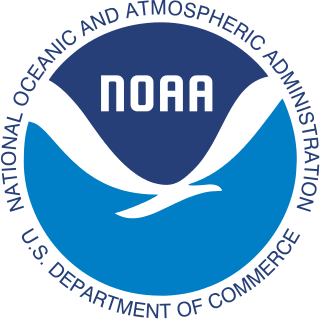
The National Oceanic and Atmospheric Administration is an American scientific agency within the United States Department of Commerce that focuses on the conditions of the oceans, major waterways, and the atmosphere.
